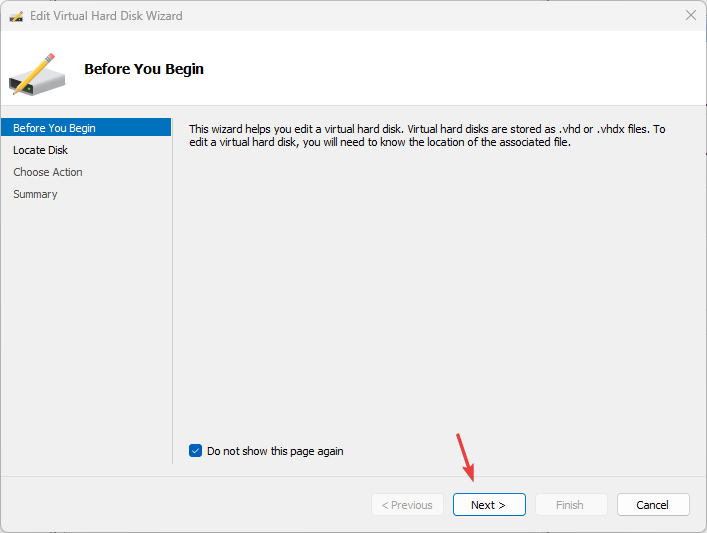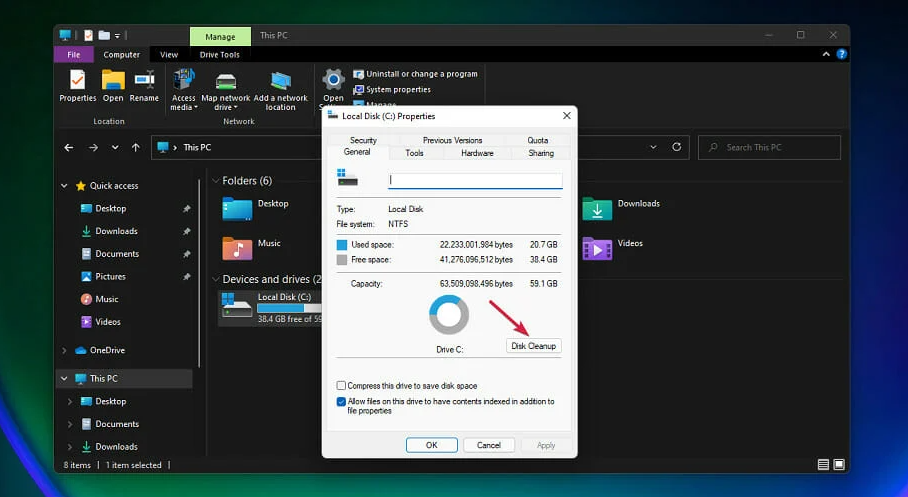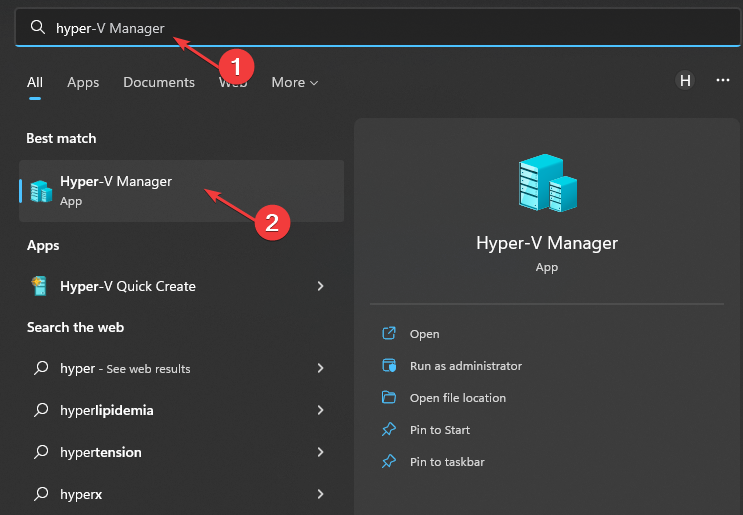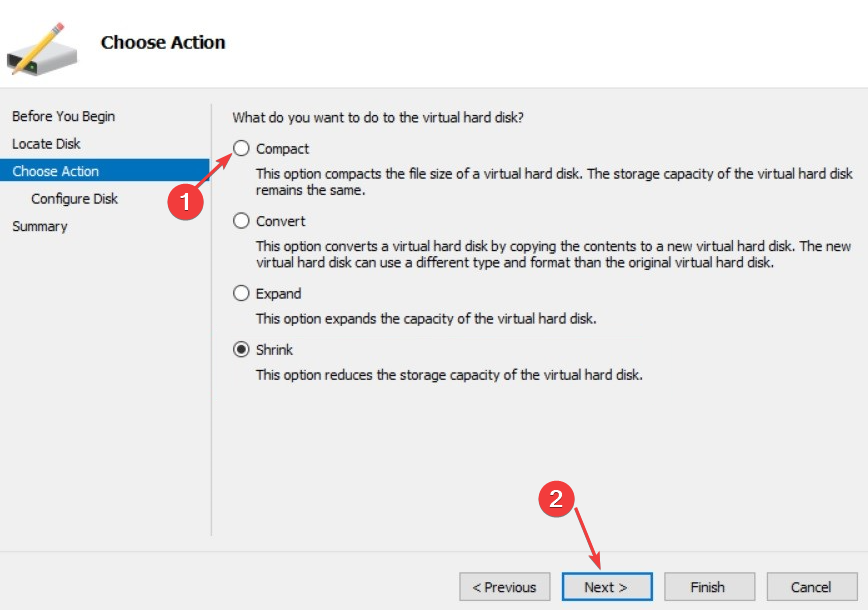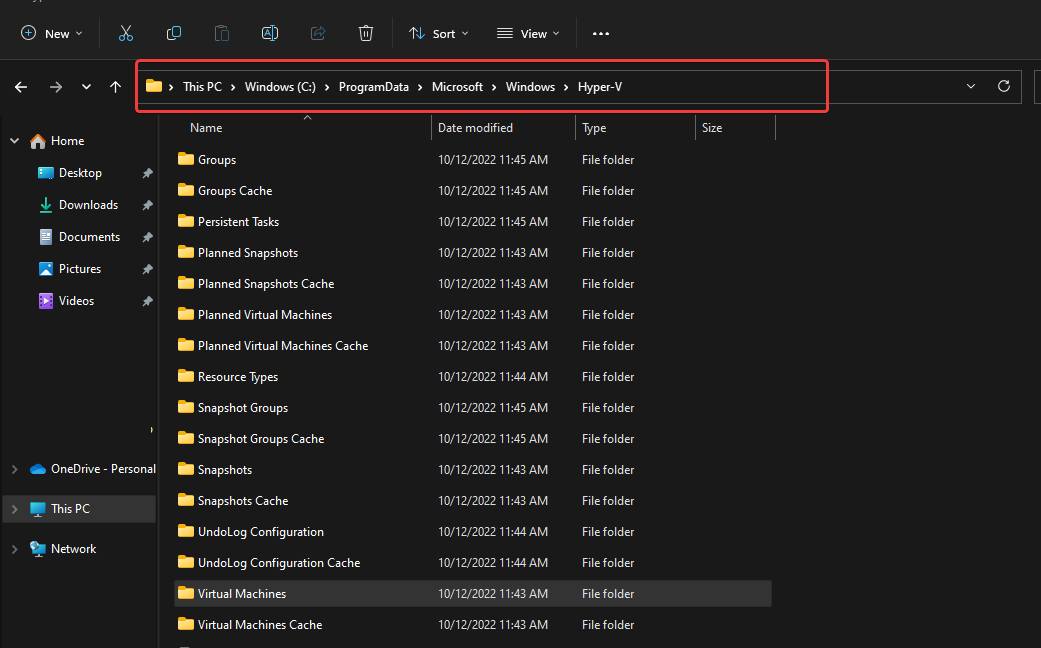- Remove From My Forums
-
Question
-
Be grateful for some advice please.
I have a virtual machine which has just gone
Paused-Critical Disk(s) running out of space on one of it’s disks.I am trying to work out how to recover. I cannot get into the VM to do anything.
I have read somewhere else that a solution is to move the VHD to a larger disk. The VHD currently fills the disk it is on.
What is the best way to do this? I notice that in Hyper-V manager settings for this VM it points to the AVHDX file on the same disk and not the VHD. So how do I change that after I move it?
I no longer have a Shutdown, Save option, or any other options except Turn Off. Advice there please. I obviously cannot move the VHD while it is running.
It’s Home Server 2011 (Windows server 2008 I think) in the VM and I am using Hyper-V under Windows 8.1.
Dave
Answers
-
Dave. I would not worry. The one thing that I know is that Hyper-V has a focus to do no harm.
Since you run a recent version, a clean shutdown should handle it.
Brian Ehlert
http://ITProctology.blogspot.com
Learn. Apply. Repeat.-
Marked as answer by
Sunday, August 3, 2014 3:28 PM
-
Marked as answer by
I was going to ask in this thread, but decided to create a new one.
https://community.spiceworks.com/topic/347951-hyper-v-2012-vm-randomly-pausing
I have read several threads about freeing up diskspace, but nothing that actually walks someone through how to do it as a novice. I am new to the Virtual world and am unsure exactly where everything is stored.
I don’t appear to have any snapshots to delete. My diskspace appears
to be fine on my host and on the VMs themselves, but I have a status of
Disk(s) running out of space on a few of my VMs. They also
critical-pause over night.
I found this in one thread:
Robert5205
Dec 24, 2015 at 7:43 AM
Keep in mind that what looks like a drive to the VM is just a
file on the host. You can delete data off the drive from inside the VM,
but it won’t shrink the size of the VHDX file on the host. To do that,
launch hyper-v manager, open settings for each VM. Select each hard
drive and choose «Edit.» Select the «Compact» option. This compacts the
file size (on the host).
I was curious if this is something that can be done live. or if the guest has to be turned off to compact the file?
This all started after I added physical RAM to the hosts. It worked fine until I tried to expand the RAM on my VMs. I have since put everything back to the original amounts of RAM, and reset all of the «tweaking» I did on the memory weights. I’m assuming this is how my disks got filled up. Now the machines will start and run during the day, but they then critical-pause at some point over night.
I also only have a shared cluster volume on one of my 2 hosts. I would think they would have identical setups. This is something I just inherited.
I do have one VM that I have identified as the «problem child»
If I unpause that one first, the others won’t start up. If I unpause all the others, then unpause that one, it starts but repauses the others. This is the machine I did the most tweaking on with dynamic memory, weight, etc…
I’m thinking I just have to do something with that VM file, but I’m not sure of the procedure
Do not hesitate to end all virtual machines not actively in use
by Henderson Jayden Harper
Passionate about technology, Crypto, software, Windows, and everything computer-related, he spends most of his time developing new skills and learning more about the tech world. He also enjoys… read more
Updated on April 2, 2023
Reviewed by
Vlad Turiceanu
Passionate about technology, Windows, and everything that has a power button, he spent most of his time developing new skills and learning more about the tech world. Coming… read more
- Not enough disk space error in Hyper-V prevents you from creating new VMs.
- Many virtual machines running can consume disk space, so it’s time to take action.
- Expanding the Hyper-V disk size can fix the issue and this isn’t the only solution.
XINSTALL BY CLICKING THE DOWNLOAD FILE
This software will repair common computer errors, protect you from file loss, malware, hardware failure and optimize your PC for maximum performance. Fix PC issues and remove viruses now in 3 easy steps:
- Download Restoro PC Repair Tool that comes with Patented Technologies (patent available here).
- Click Start Scan to find Windows issues that could be causing PC problems.
- Click Repair All to fix issues affecting your computer’s security and performance
- Restoro has been downloaded by 0 readers this month.
Hyper-V not having enough disk space is an error most users complain about frequently, so you’re not alone. This issue prevents users from running multiple virtual machines and results in many Hypervisor errors on Windows 11.
How much disk space does Hyper-V need to run multiple VMs?
Memory is one of the essential components of the Hypervisor. You need to allocate memory to virtual machines for them to be able to run.
A standard Hyper-V host requires about 4 GB of memory space to run Hyper-V and the management operating system.
However, running multiple virtual machines calls for more memory usage. So, users should assign bigger memory space.
Nevertheless, running into this error on Hyper-V can occur due to many factors. The major ones are:
- Many virtual machines run synchronously: The free disk space on your device may not be enough to run the entire machine on Hyper-V. So, you can run into errors trying to run additional VMs.
- Background programs: Many programs running in the background can consume your disk space. They use more disk space, leaving no memory space for the Hyper-V VMs.
Many other factors can cause a shortage in memory space in Hyper-V. You can read about fixing Hyper-V that ran out of memory errors to understand the problem better.
What can I do if there’s not enough disk space in Hyper-V?
Before anything else, consider doing these preliminary checks:
- Close unnecessary running programs on your PC that may be consuming the disk space.
- Check disk space on Hyper-V to know how much space is available.
- Free some memory space on your computer and restart your computer to check if the memory error is fixed.
- An excellent way to free up disk space in Hyper-V for multiple virtual machines is to close other unnecessary VMs. It’ll create more memory space for the new virtual machines to establish. However, we have a detailed guide on what to do if you have issues with virtual machine management in Windows 11.
Some PC issues are hard to tackle, especially when it comes to corrupted repositories or missing Windows files. If you are having troubles fixing an error, your system may be partially broken.
We recommend installing Restoro, a tool that will scan your machine and identify what the fault is.
Click here to download and start repairing.
If after these, the error persists, proceed to the advanced fixes below.
1. Expand Hyper-V disk size via Hyper-V Manager
- Click Start, type hyper in the search box, then press Enter.
- Select the Hyper-V Manager from the search results.
- Click on the virtual machine you want to expand its disk, then select the Edit Disk option to prompt the Edit Virtual Hard Disk wizard.
- Click on Next to locate the Disk window, then click the Browse button to find the path of the virtual hard disk.
- Select the file and click Open, then click Next.
- Choose Expand on the Choose Action page and click Next.
- Select the Configure Disk option and input a larger size in the New size space, then click Next.
- Click Finish.
Restart your PC and check if the memory issue persists. If you encounter Hyper-V error when applying hard drive changes, take a look at this guide.
2. Perform a disk cleanup
- Press Start, type this PC in the search box, and click Enter.
- Select the first search result, and right-click on the drive you want to clean up.
- Choose Properties from the drop-down, then click on Disk Cleanup.
- Select the files you want to delete and click OK
- Click on Clean Up System Files and wait for the cleaner to calculate everything.
- Select the file to delete, then press OK after selecting.
We recommend you read how to free up Disk space on Windows 11 for further information on this.
- What is Netplwiz.exe & How to Properly Use it
- 3 Ways to Bypass Windows 11 System Requirements
- How to Disable Efficiency Mode on Windows 11
- Smart App Control on Windows 11: How to Turn it On or Off
3. Initiate Compact Virtual Hard Disks
- Click Start, type hyper in the search box, then press Enter.
- Click on the Hyper-V Manager from the search results.
- Specify the virtual machine you want to expand its disk.
- Select Edit Disk to open the Edit Virtual Hard Disk wizard.
- Select the virtual hard disk whose size you want to reduce.
- Choose Compact, then click Finish.
By initiating a compact disk, more spaces will be available from the shrunk VM memory.
4. Clear deleted VM files
- Open File Explorer on your PC by pressing the Windows + E keys.
- Check for the VMs you recently deleted that are still in the folder by following this navigation:
C:ProgramDataMicrosoftWindowsHyper-VVirtual Machines - Right-click on the virtual machine and select Delete from the drop-down. (If it is empty, close it)
Deleting the VM files of deleted virtual machines will free up disk space. However, we advise that you use Hyper-V backup software to back up your VMs to be able to access them after being deleted.
Alternatively, you can check how to run disk cleanup on Windows 11. Also, you can read our article on how to fix Hypervisor not running on Windows 11.
If you have questions or suggestions, you can leave them in the comments section. We’d like to hear from you.
Still having issues? Fix them with this tool:
SPONSORED
If the advices above haven’t solved your issue, your PC may experience deeper Windows problems. We recommend downloading this PC Repair tool (rated Great on TrustPilot.com) to easily address them. After installation, simply click the Start Scan button and then press on Repair All.
-
duhej
- Novice
- Posts: 4
- Liked: never
- Joined: May 11, 2017 4:09 am
- Full Name: 111
Snapshots and low disk space
Good afternoon. There is MS Server 2016 (2 pieces: VM source and VM receiver) and VBR U2 and configured in it backup and VM replication tasks from source Hyper-V to receiver Hyper-V. Periodically, randomly, on the HDD (on the VM source) with the VM, snapshots of the VM are created and then the free space on the disk with the VM ends and then the VMs do not work. This is totaly not necessary and creates a lot of problem problems for me. How to completely disable the creation of snapshots on the VM source, so that all backups and replicas are created ONLY to receiver Hyper-V?
-
Mike Resseler
- Product Manager
- Posts: 7882
- Liked: 1203 times
- Joined: Feb 08, 2013 3:08 pm
- Full Name: Mike Resseler
- Location: Belgium
- Contact:
Re: Snapshots and low disk space
Post
by Mike Resseler » May 11, 2017 4:34 am
Hi @duhej,
First: Welcome to the forums!
I am not sure if I completely follow. Our replication technology is based on snapshot creation so we need to create a snapshot or we can’t replicate the changes. That being said. If you are running out of disk space, that means that either it takes a long time for the replication which means there is a lot of changes that need to be processed or you are really low on disk space.
How much space do you have left? Are the checkpoints (new MSFT name for snapshots) placed on the same disk or redirected to another location?
Thanks
Mike
-
duhej
- Novice
- Posts: 4
- Liked: never
- Joined: May 11, 2017 4:09 am
- Full Name: 111
Re: Snapshots and low disk space
Post
by duhej » May 11, 2017 2:47 pm
First: thanks for answer.
Second: i have source hyper-v and reciever hyper-v. I totaly do not need any snapshots or another changes to original VM vhdx files placed at source hyper-v. For snapshots or another changes i have reciever hyper-v. I have 1000 gb and I am running out of disk space, because there are a lot of snapshots of VM (at source hyper-v) placed on the same disk and this is the real problem.
-
Mike Resseler
- Product Manager
- Posts: 7882
- Liked: 1203 times
- Joined: Feb 08, 2013 3:08 pm
- Full Name: Mike Resseler
- Location: Belgium
- Contact:
Re: Snapshots and low disk space
Post
by Mike Resseler » May 11, 2017 2:57 pm
You do need a temporary snapshot at the source side when the replication starts. Otherwise it is not possible to do the replication.
When you look here in our manual on how it works: https://helpcenter.veeam.com/docs/backu … tml?ver=95
in point 8 you see: Veeam Backup & Replication requests Microsoft Hyper-V VSS to create a cohesive point-in-time copy of a VM. Microsoft Hyper-V VSS creates a volume snapshot or VM checkpoint, depending on the hypervisor version.
But that snapshot should be removed after the replication job is done
Mike
-
duhej
- Novice
- Posts: 4
- Liked: never
- Joined: May 11, 2017 4:09 am
- Full Name: 111
Re: Snapshots and low disk space
Post
by duhej » May 13, 2017 7:16 am
Ok, so if there are a lot snapshots (chain of snapshots) at the same disk — something is wrong?
-
Mike Resseler
- Product Manager
- Posts: 7882
- Liked: 1203 times
- Joined: Feb 08, 2013 3:08 pm
- Full Name: Mike Resseler
- Location: Belgium
- Contact:
Re: Snapshots and low disk space
Post
by Mike Resseler » May 15, 2017 10:36 am
Hi,
Yeah, I think something is wrong at that point in time. This could be for many reasons, and one of it could be Veeam (although when it is a chain, I doubt it but still…).
Now the issue with a chain of snapshots is that it could be dangerous to «remove» or «apply» them. So at this point in time, I would advise you to create a support call and let our engineers see if the issue is related to us or not, and at the same time they most probably will advise you what the best next step is to do (if it is not us that creates the chain at least…)
Please post the support ID here and the follow-up after working with support
Thanks
Mike
-
duhej
- Novice
- Posts: 4
- Liked: never
- Joined: May 11, 2017 4:09 am
- Full Name: 111
-
Calby
- Enthusiast
- Posts: 25
- Liked: never
- Joined: Jan 22, 2018 6:48 pm
- Full Name: Robin Johansson
- Contact:
[MERGED] How much free space do I need at datastore?
Post
by Calby » Feb 19, 2018 8:44 am
Hi,
I have notice that if the free space on the datastore disk goes under xxx then I can’t backup with Veeam.
I have googled but I can’t find out what the limit is?
How much free space do I need on the datastore?
Is it over 5% of the total harddrive space that needs to bee free?
-
Mike Resseler
- Product Manager
- Posts: 7882
- Liked: 1203 times
- Joined: Feb 08, 2013 3:08 pm
- Full Name: Mike Resseler
- Location: Belgium
- Contact:
[MERGED] Re: How much free space do I need at datastore?
Post
by Mike Resseler » Feb 19, 2018 8:55 am
Robin,
The reason of that free space is because we need to take a snapshot of the Hyper-V VM. At that moment, what happens is that the original VHD(X) gets «frozen» (read-only) and all writes are going to a differential file (AVHD(X)). This is the way the backup of VM’s work in Hyper-V (and for that matter, more or less the same in VMware). If the datastore is low on space that file can’t be placed there and also the merge (after the backup) won’t be possible as it needs additional space also (working space, it gets free again after that)
You say 5%, but how much is that in GB? And what is your host OS? And lastly, what is the size off the VM in total?
-
Calby
- Enthusiast
- Posts: 25
- Liked: never
- Joined: Jan 22, 2018 6:48 pm
- Full Name: Robin Johansson
- Contact:
Re: [MERGED] Re: How much free space do I need at datastore?
Post
by Calby » Feb 19, 2018 9:03 am
Mike Resseler wrote:Robin,
The reason of that free space is because we need to take a snapshot of the Hyper-V VM. At that moment, what happens is that the original VHD(X) gets «frozen» (read-only) and all writes are going to a differential file (AVHD(X)). This is the way the backup of VM’s work in Hyper-V (and for that matter, more or less the same in VMware). If the datastore is low on space that file can’t be placed there and also the merge (after the backup) won’t be possible as it needs additional space also (working space, it gets free again after that)
You say 5%, but how much is that in GB? And what is your host OS? And lastly, what is the size off the VM in total?
Hi,
I’m running Hyper-V in Win2016.
The guest OS are running on a seperated SSD the system of the Guest OS. No issue there, but my storage disks that are attached to the VM are almost full and aldo they are not included in the backup (I have choosen to only backup system disk 0:0) it seem that they are making some issue.
I have excluded them from the backup in Veeam but they are still making some kind of issue.
First disk are 2,72GB with 94,6GB free (I can adjust this so I get more free space but then I need to know the limit, how much free space do I need)
The second disk 2,72GB with 125GB Free (Same here I can adjust it, but then I need to know how much free space I need)
Third disk is total 209GB (Don’t know how much free space is have, but it’s making some alerats)
-
Mike Resseler
- Product Manager
- Posts: 7882
- Liked: 1203 times
- Joined: Feb 08, 2013 3:08 pm
- Full Name: Mike Resseler
- Location: Belgium
- Contact:
Re: Snapshots and low disk space
Post
by Mike Resseler » Feb 19, 2018 9:07 am
Hmm. I would rather say you have space enough for those sizes. But, I might be wrong here but your VMs OS disk is only 2.72 GB? that seems low if it is a windows VM?
The disk free space I cannot calculate because it depends on how much churn there is (and the growth of the AVHDX because of that). If it is a very busy VM during the backup, it will be a big AVHDX file (could even be bigger than the original one if many changes occur).
How much is the total size of those datastores?
-
Calby
- Enthusiast
- Posts: 25
- Liked: never
- Joined: Jan 22, 2018 6:48 pm
- Full Name: Robin Johansson
- Contact:
Re: Snapshots and low disk space
Post
by Calby » Feb 19, 2018 9:14 am
Mike Resseler wrote:Hmm. I would rather say you have space enough for those sizes. But, I might be wrong here but your VMs OS disk is only 2.72 GB? that seems low if it is a windows VM?
The disk free space I cannot calculate because it depends on how much churn there is (and the growth of the AVHDX because of that). If it is a very busy VM during the backup, it will be a big AVHDX file (could even be bigger than the original one if many changes occur).
How much is the total size of those datastores?
Sorry I do mean TB not GB sorry for that, the total space is in TB and the space left is in GB.
Beside the 209GB disk that one is 209GB in total.
The AVHDX is big on this diskes, they are over 2TB in size.
Production drive E: is getting low on free space (125,3 GB left), and may run out of free disk space completely due to open snapshots.
Production drive K: is getting low on free space (96,5 GB left), and may run out of free disk space completely due to open snapshots.
AVHDX sizes:
K: 2,61 TB
E: 2,59 TB
-
Mike Resseler
- Product Manager
- Posts: 7882
- Liked: 1203 times
- Joined: Feb 08, 2013 3:08 pm
- Full Name: Mike Resseler
- Location: Belgium
- Contact:
Re: Snapshots and low disk space
Post
by Mike Resseler » Feb 19, 2018 9:22 am
That means you are already running on snapshots for some time I think. Can you check on Hyper-V manager to see if there are open snapshots? Potentially multiple?
-
Calby
- Enthusiast
- Posts: 25
- Liked: never
- Joined: Jan 22, 2018 6:48 pm
- Full Name: Robin Johansson
-
Contact:
Re: Snapshots and low disk space
Post
by Calby » Feb 19, 2018 9:33 am
Mike Resseler wrote:That means you are already running on snapshots for some time I think. Can you check on Hyper-V manager to see if there are open snapshots? Potentially multiple?
No, no other snapshots.
And I have tried to run Veeam again.
Then I get: 2018-02-19 10:30:43 :: Processing Media Error: Skipping VM processing due to insufficient free disk space on drive E:.
I guess that I get this error now because I have increased the «Skip VM processing when free disk space are below» to 5% again as I did try to turn it down to 1% before.
If I have it on 1% I do get this kind of warnings as I did write about above.
But is the free diskspace limit 5% on the datastore disks?
Edit:
My guess is that I did get the first warning because when Veeam are opening a snapshot it get’s out of free space — this is based on that when I do increase the «Skip VM processing when free disk space are below» to 5% I do get a error because of low diskspace and if I lower or turn the «Skip VM processing when free disk space are below» of then I get a warning.
Because I don’t have any other kind of snapshot opened.
So if I do increse the free diskspace this should be solved, but as I don’t know the free space limit it’s kind of hard to do =/
Can you point me to the right direction?
-
Mike Resseler
- Product Manager
- Posts: 7882
- Liked: 1203 times
- Joined: Feb 08, 2013 3:08 pm
- Full Name: Mike Resseler
- Location: Belgium
-
Contact:
Re: Snapshots and low disk space
Post
by Mike Resseler » Feb 19, 2018 9:41 am
From what I read here, I think it is indeed on the disks that hold the VMs.
I would suggest at this point in time to open a support call so our engineers can help you with (at least I believe this will be the way to go if I read everything correctly) merging the AVHDX file (unless that AVHDX is from a cluster disk, which unfortunately also uses AVHDX as extension) and then work further from there. As long as we don’t have the space, we can’t take that backup. If you run out of it… Well, you want to avoid that
I think it is better that the engineers look at it with the logs and also maybe with a support session because if I would give you advice to do a merge here, without actually seeing what is going on, I might give you the wrong advice and you could loose production data which I don’t want to happen
Please post the support case ID here and the outcome after investigation/ working with the engineers
Thanks
Mike
-
Calby
- Enthusiast
- Posts: 25
- Liked: never
- Joined: Jan 22, 2018 6:48 pm
- Full Name: Robin Johansson
- Contact:
Re: Snapshots and low disk space
Post
by Calby » Feb 19, 2018 10:27 am
Mike Resseler wrote:From what I read here, I think it is indeed on the disks that hold the VMs.
I would suggest at this point in time to open a support call so our engineers can help you with (at least I believe this will be the way to go if I read everything correctly) merging the AVHDX file (unless that AVHDX is from a cluster disk, which unfortunately also uses AVHDX as extension) and then work further from there. As long as we don’t have the space, we can’t take that backup. If you run out of it… Well, you want to avoid that
I think it is better that the engineers look at it with the logs and also maybe with a support session because if I would give you advice to do a merge here, without actually seeing what is going on, I might give you the wrong advice and you could loose production data which I don’t want to happen
Please post the support case ID here and the outcome after investigation/ working with the engineers
Thanks
Mike
I did fix the issue by my self, it was like I did think.
The total space for one of my disk was 2785GB (2,72TB) so I did take -6% (167,1gb) of that and that is 2617,9GB so I did round it down so what I did was that I did format the VHDX to only use max 2600GB and now everything works like a charm
Now I know that I never can get that kind of issue again with this disk I guess (hope).
-
Mike Resseler
- Product Manager
- Posts: 7882
- Liked: 1203 times
- Joined: Feb 08, 2013 3:08 pm
- Full Name: Mike Resseler
- Location: Belgium
-
Contact:
Re: Snapshots and low disk space
Post
by Mike Resseler » Feb 20, 2018 6:03 am
That is actually a great tip! I’m sure others will benefit from this also when having the same problem.
Thanks for letting us know, and I am glad that you have solved it!
Cheers
Mike
Disk(s) Running out of Space
Hey All, Having an issue on Windows 2012 R2. The Hyper-V Role is pausing my VMs with the Status — «Disk(s) Running out of Space». The Hosts Disk they are all saved on has 4TB of Free space left! They are all fixed sized VMs also. Is there a way to stop Hyper-V pausing the VMs? Is this a known bug or am I having a bad day? Checked a few forums and in every time people generally had low space, but 4TB is plenty… Any help or advice appreciated 
Archived post. New comments cannot be posted and votes cannot be cast.




